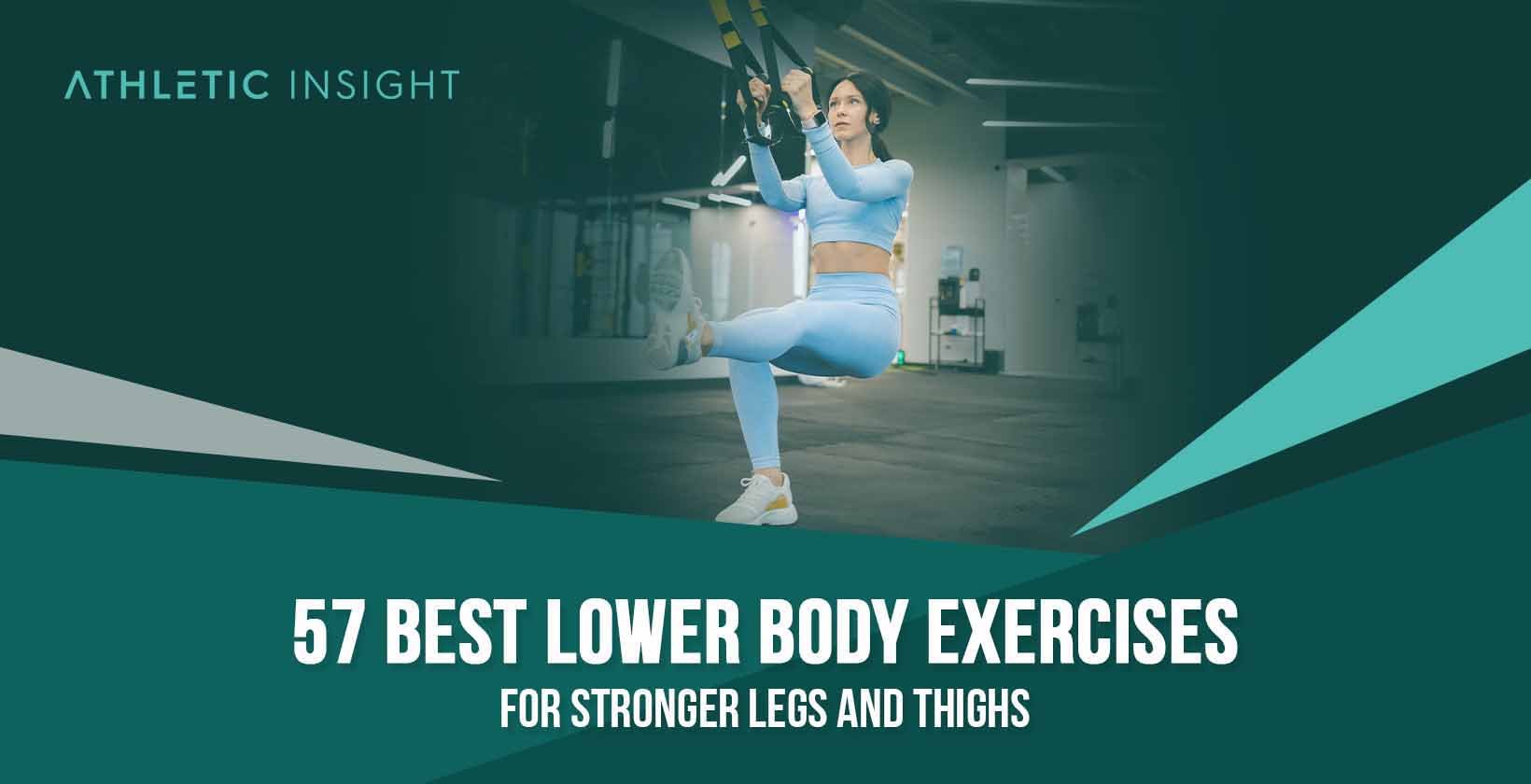The lower body consists of your legs, ankles, and feet. It makes up half of the human body, and exercising it regularly and thoroughly is important. Ignoring the lower body while exercising can result in adverse consequences and injury.
The main benefits of having a strong lower body are that it gives you a solid foundation to carry your upper body. You need to use your lower body for most movements, and a strong lower body can maximize the gains of upper body exercises.
Lower body exercises can help improve blood circulation, and cardiovascular health, improve bone health, reduce injuries, and help you lose weight. The top three lower body exercise movements on this list are dumbbell squats, deadlifts, and calf raises. Keep reading to learn about the other 54 exercises on this list.
If you are looking for the best lower body exercises, you have come to the right place. This article covers the 57 best lower body exercises to improve the strength of your legs and thighs. Each of these exercises will help you build a stronger foundation.
1. Jumping Jacks
Jumping jacks are a plyometric exercise that works your quads, glutes, hamstrings, and core. It is a straightforward exercise that you can add to any workout routine.
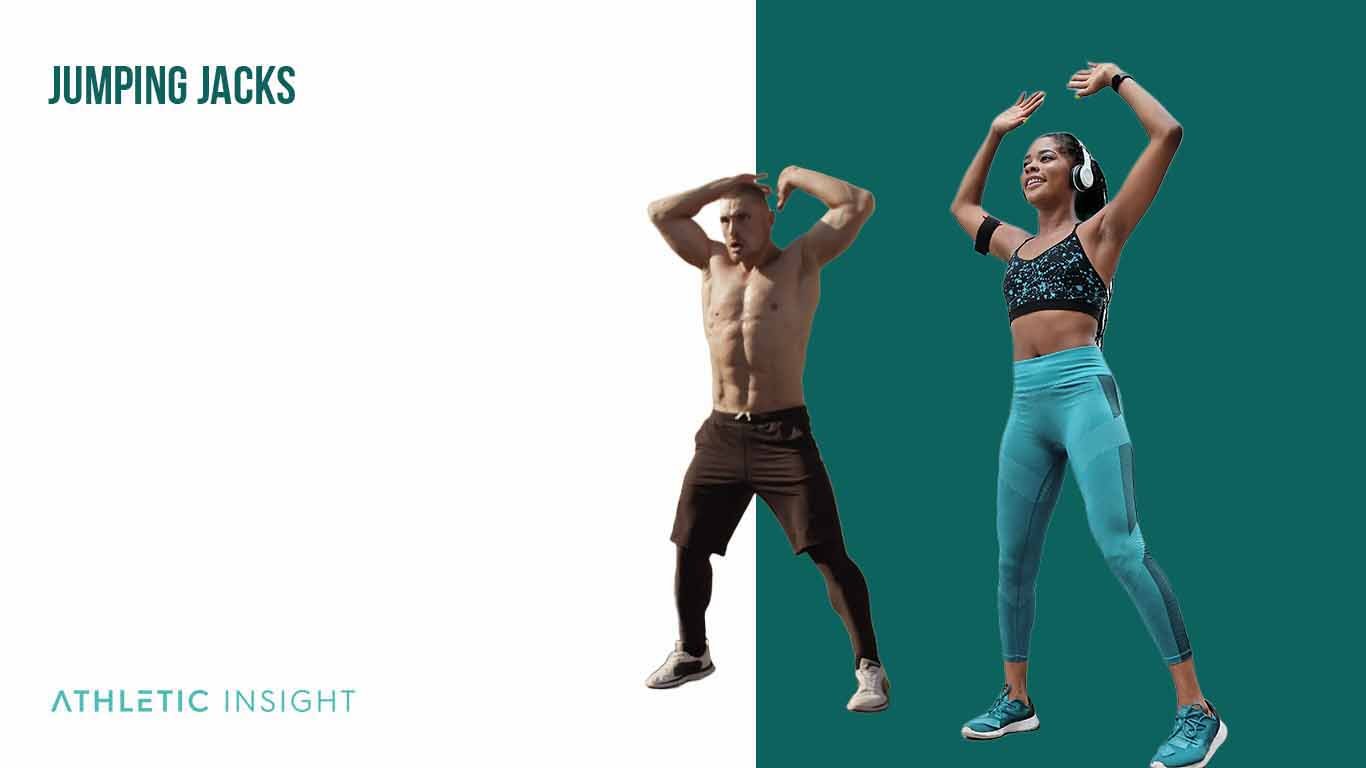
- Start by standing with your feet and arms at your sides.
- Jump up and spread your legs out to the sides.
- At the same time, raise your arms above your head.
- As you land, jump back to the starting position.
- Repeat this movement for 30 seconds to 1 minute.
2. Split Squats
Split squats are a compound leg exercise that targets various muscles in the lower body. The muscles that are targeted during the split squat are the quads, hip flexors, glutes, and hamstrings.
- Start by standing with your feet shoulder-width apart.
- Take a significant step forward with your right leg and lower your body until your left knee is close to touching the ground.
- Return to the starting position and repeat with your left leg.
3. Glute Bridges
Glute bridges effectively exercise your glutes, hamstrings, and core. This exercise also helps improve your flexibility and range of motion in your hips.
- Start by lying on your back with your feet flat on the ground, and keep your knees bent.
- Raise your hips off the ground and squeeze your glutes at the top of the movement.
- Hold this position for 2 to 3 seconds before returning to the starting position.
4. Single-Leg Hip Bridges
Single-leg hip bridges help you exercise your hamstrings, hip flexors, lower back muscles, and glutes. This exercise is more challenging than a traditional glute bridge and allows you to target one side of your hips.
- Lie on your back with one leg extended straight in the air and the other leg bent with your foot flat on the ground.
- Raise your hips off the ground and squeeze your glutes at the top of the movement.
- Hold this position for 2 to 3 seconds before returning to the starting position.
5. Bird Dogs
The bird dog exercise hits the erector spinae, your rectus abdominis, and the glutes. These muscles enable correct limb movement, posture, and control in the entire body.
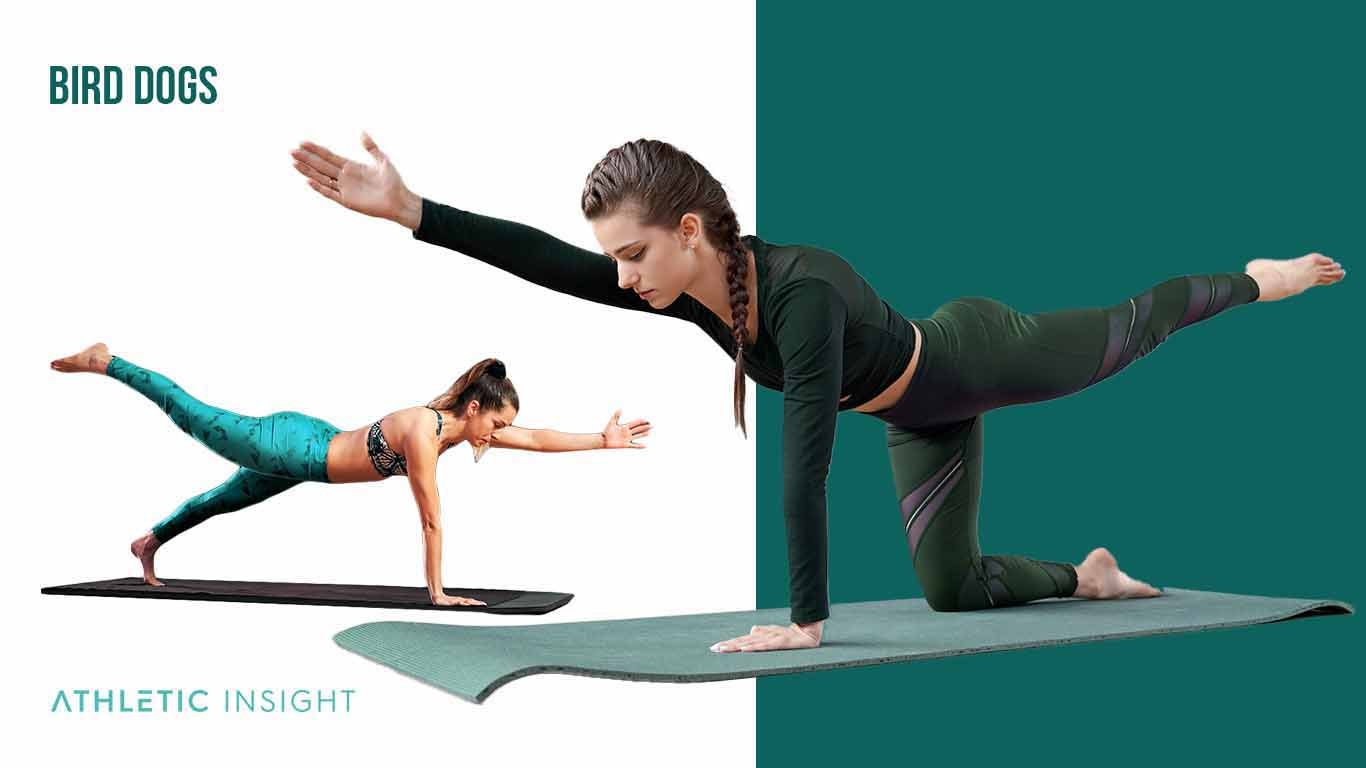
The bird dog is a suitable workout for people with low back problems, such as hypermobility, and it can aid in developing good balance and posture.
- Begin on all fours with your hands and knees shoulder-width apart.
- Raise your right arm and left leg off the ground and hold this position for 2 to 3 seconds
- Return to the starting position and repeat with your left arm and right leg.
6. Donkey Kicks
Donkey kicks are one of the most effective lower body exercises because of the number of muscles it targets. Each donkey kick exercises your glutes, core, hamstrings, shoulders, and back.
- Start on all fours with your hands and knees shoulder-width apart.
- Raise your right leg off the ground and kick back until your leg is in line with your spine.
- Return to the starting position and repeat with your left leg.
7. Dead Lifts
Deadlifts are among the most popular lower body exercises because they exercise many different muscle groups. When you do a deadlift, you train your hamstrings, glutes, back, hips, core, and traps. Your form is essential when completing a deadlift, so be sure to follow this procedure closely.
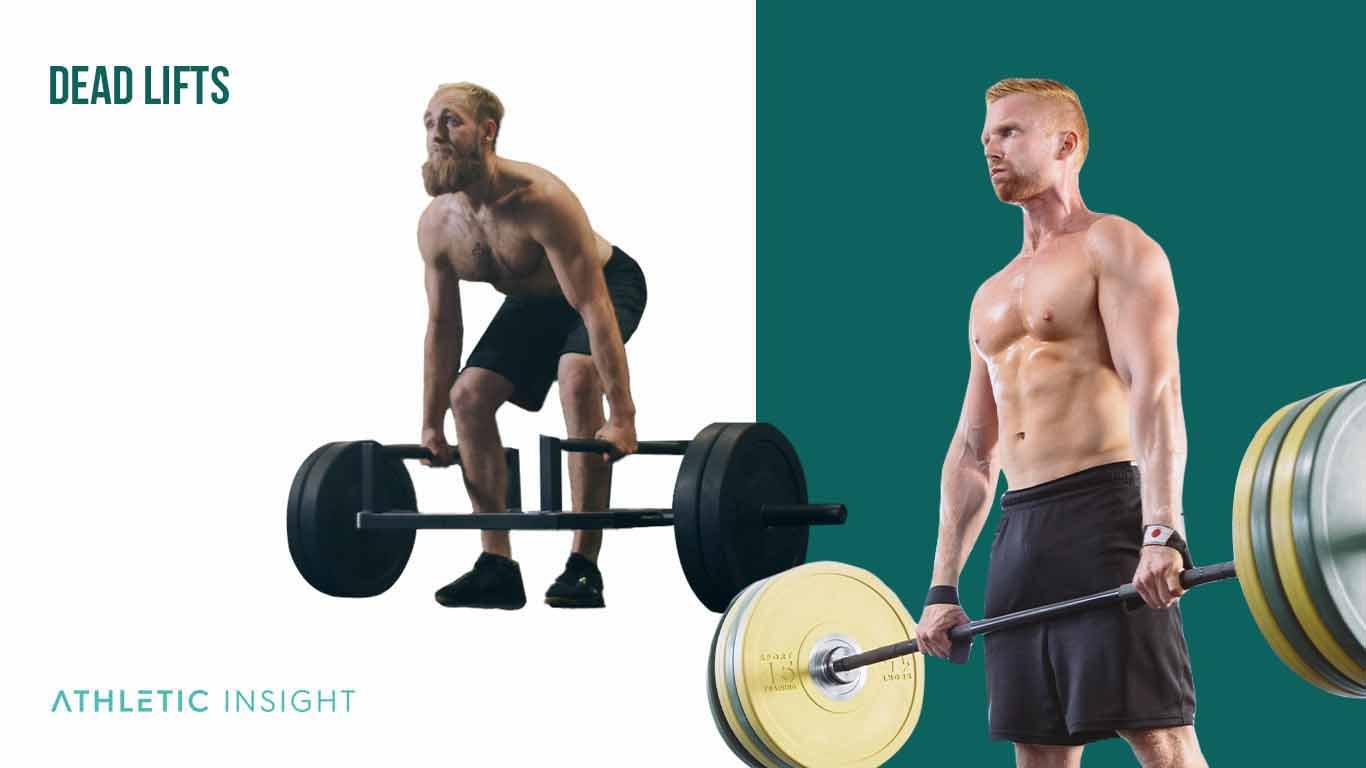
- Start by standing with your feet hip-width apart.
- Bend down and grip the barbell with your hands shoulder-width apart.
- From here, lift the barbell until you’re standing upright, then lower it back to the starting position.
8. Single-Leg Dead Lifts
Single-leg deadlifts provide all the advantages of regular deadlifts but put additional strain on your core. This exercise is ideal for people who want to increase their balance and stability. The form of a single-leg deadlift follows the same principles as a standard deadlift.
- Start by standing on your left leg with your right leg bent behind you.
- Lean forward and grip the barbell with your right hand.
- From here, lift the barbell until your left leg is straight, and then lower it back down to the starting position.
- Repeat with your right leg.
9. Forward Lunges
Forward lunges work the majority of the muscle groups in your lower body, including the hamstrings, quads, hip flexors, glutes, and adductors.
- Start by standing with your feet together.
- Take a large step forward with your right leg and lower your body until your right knee bends at a 90-degree angle.
- Return to the starting position and repeat with your left leg.
10. Lateral Lunges
Lateral lunges target your glutes, hamstrings, and quads. This exercise can assist people who want to improve their balance and stability.
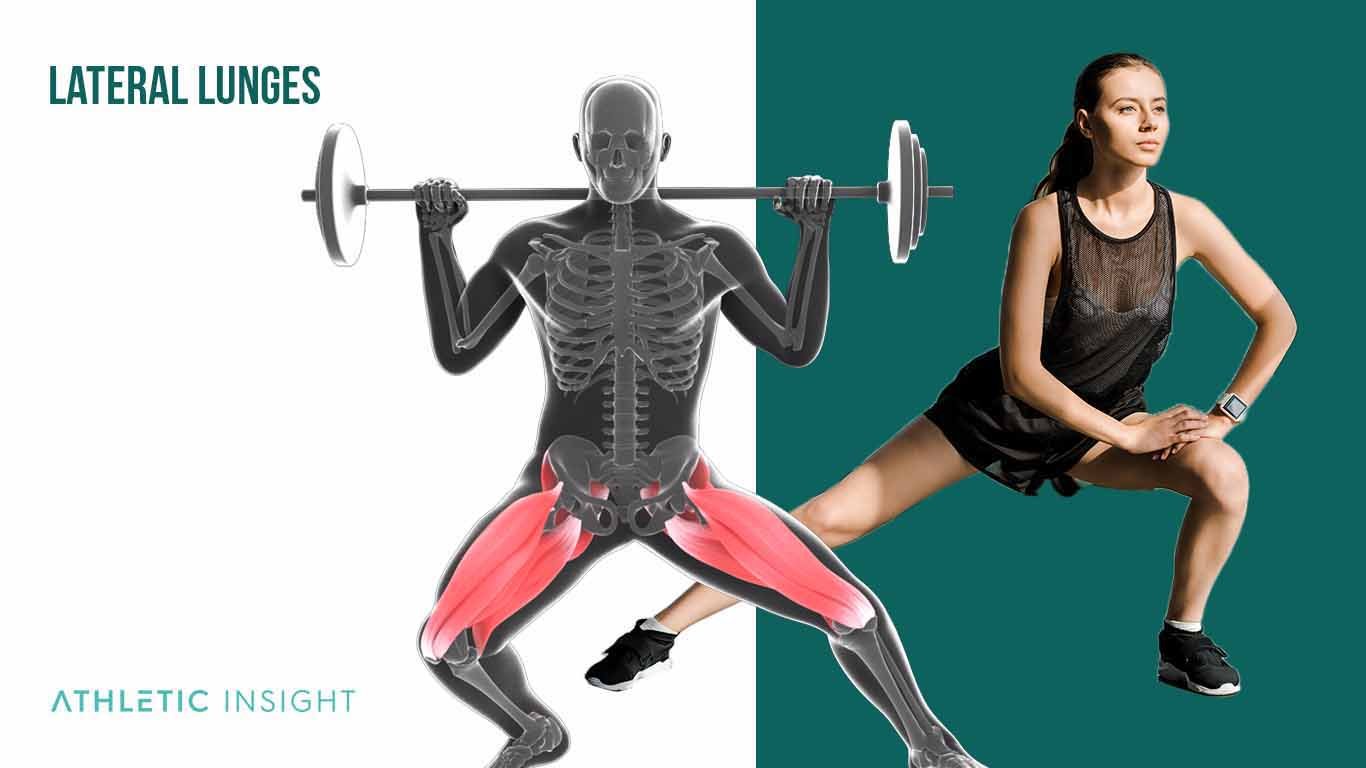
- Start by standing with your feet together.
- Take a large step to the right with your right leg and lower your body until your right knee bends at a 90-degree angle.
- Return to the starting position and repeat with your left leg.
11. Reverse Lunges
Reverse lunges are a powerful exercise for toning your glutes, thighs, and calves. The proper form of reverse lunge comprises the following steps.
- Start by standing with your feet together.
- Take a large step backward with your right leg and lower your body until your right knee bends at a 90-degree angle.
- Return to the starting position and repeat with your left leg.
12. Calf Raises
Calf raises are one of the most straightforward lower body exercises because you can do them anywhere. The calf raise target the muscles in your lower legs, specifically your calves.
- Stand with your feet shoulder-width apart.
- Lift your toes and hold for 2 to 3 seconds—lower back down to the starting position and repeat.
13. Step-Ups
Step-ups are an effective lower body conditioning exercise. It mimics climbing stairs which will help you build functional strength. Step-ups also target the muscles in your glutes, thighs, and calves.
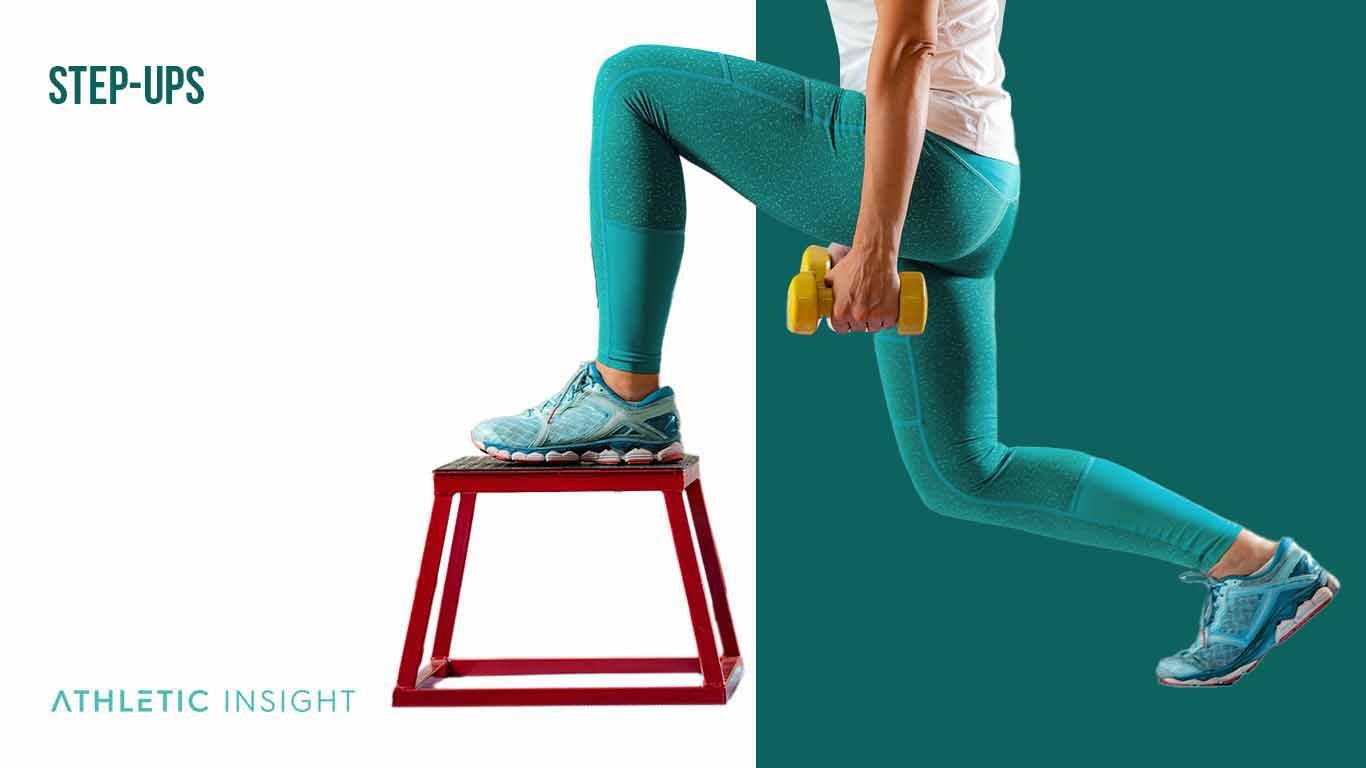
- Stand in front of a box or step.
- Place your right foot on top of the box and press down, driving your left leg up until both legs are straight.
- Reverse the movement and return to the starting position.
- Repeat with your left leg.
14. Dumbbell Squat
Dumbbell squats target most of the major muscle groups in your legs, including the quads, glutes, hamstrings, and soleus.
- Start by standing with your feet shoulder-width apart and a dumbbell in each hand.
- Lower your body down into a squat position.
- Keep your chest up and your knees behind your toes as you lower down.
- Reverse the movement and press back up to your original position.
15. Dumbbell Goblet Squat
Dumbbell goblet squats are more targeted than other squat forms. This exercise activates your quadriceps and glutes. It also works your core and biceps.
- Start by standing with your feet shoulder-width apart and holding a dumbbell in front of your chest with both hands.
- Lower your body down into a squat position.
- Keep your knees behind your toes as you lower down.
- Reverse the movement and return to your original position.
16. Bulgarian Split Squat
Bulgarian split squats are among the most effective and challenging lower body exercises. This whole lower body exercise activates your quads, glutes, hamstrings, calves, adductors, and abs.
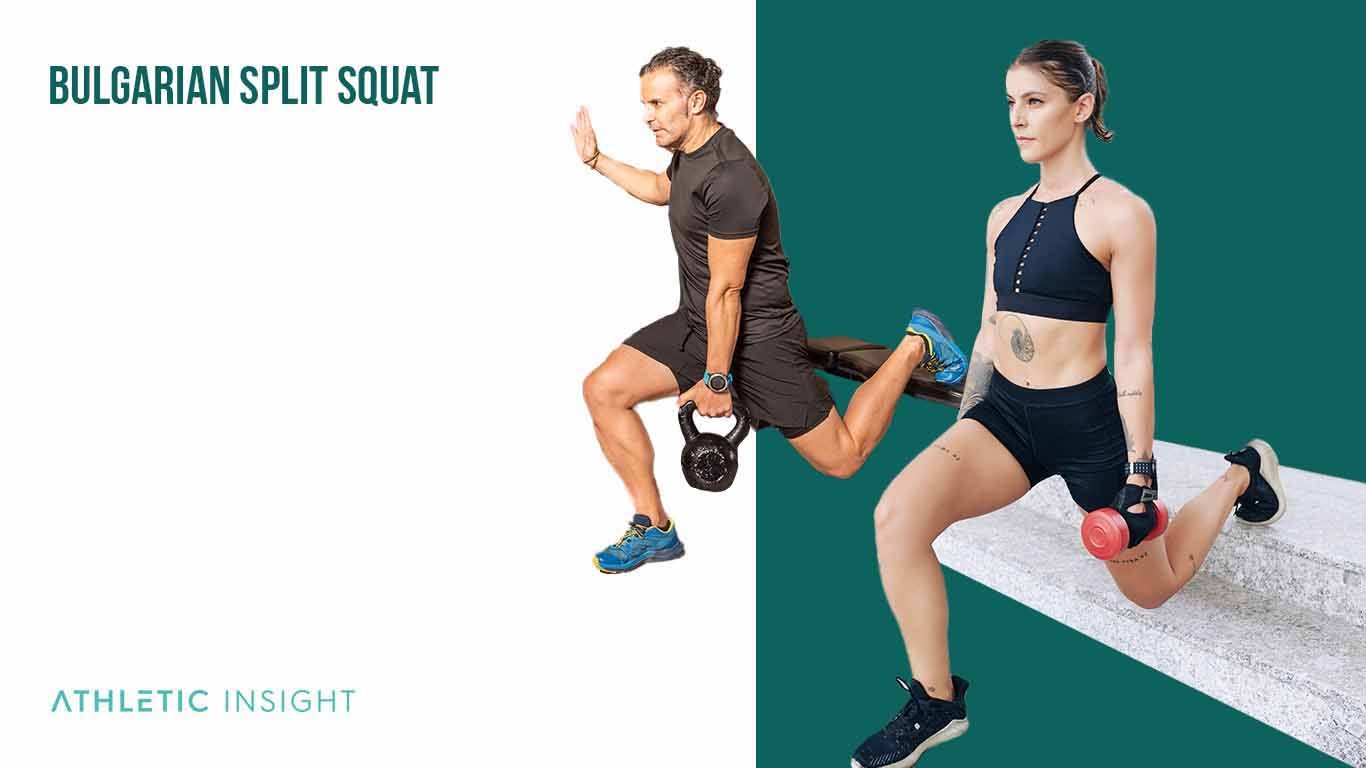
- Stand in front of a bench or box.
- Place your left foot on the top of the bench and your right foot about 2 feet in front of you.
- Bend your knees and lower your body until your right thigh is parallel to the ground.
- Reverse the motion and return to your original position.
- Repeat with your left leg. As you gain strength, you can begin doing this exercise with weights.
20. Curtsy Lunge
Curtsy lunges are similar to forward lunges but with a twist. This exercise targets your quads, hamstrings, glutes, and adductors.
- Start by standing with your feet shoulder-width apart and your hands on your hips.
- Take a large step backward and to the right with your right leg and lower your body until your left knee bends at a 90-degree angle.
- Return to the starting position and repeat on your left side.
21. Clamshell
Clamshells can help you target your hip abductor muscles. These muscles are responsible for moving your legs away from your body. This exercise is perfect for women who want to improve their hip stability and prevent injuries.
- Start by lying on your right side with your knees and feet together.
- Place your right hand on the ground in front of you for support.
- Lift your left knee toward the ceiling as high as possible.
- Hold for 2 seconds and then return to the starting position.
- Repeat on your right side.
23. Plié Squat
Plié squats are exercises for toning your inner thighs and glutes. This exercise also works your quads and hamstrings.
- Stand with your feet wider than shoulder-width apart and your toes turned out.
- Lower your body down into a squat and hold for 2 seconds.
- Return to the starting position and repeat for the desired number of reps.
24. Forward-Backward Lunge
Forward-backward lunges are lower body exercises for working your quads, hamstrings, glutes, and adductor muscles. This exercise also works your hip flexors.
- Start by standing with your feet shoulder-width apart and your hands on your hips.
- Take a large step forward with your right leg and lower your body until your left knee bends at a 90-degree angle.
- Return to the starting position and take a large step backward with your right leg.
- Lower your body until your left knee bends at a 90-degree angle.
- Return to the starting position and repeat on your left side.
25. Alternating Side Lunge
Alternating side lunges help to work your lower body muscles. This exercise targets your quads, hamstrings, inner thighs, outer thighs, and core.
- Start by standing with your feet shoulder-width apart and your hands on your hips.
- Step to the right with your right leg and lower your body until your left knee bends at a 90-degree angle.
- Return to the starting position and repeat on your left side.
- Continue alternating sides for the desired number of reps.
26. Reverse Lunge and Kick
Forward lunges are effective lower body exercises, but they also put a lot of stress on your knees and ankles. If you suffer from joint pain in these areas, reverse lunges and kicks are an alternative. This exercise targets your quads, hamstrings, glutes, and core.
- Start by standing with your feet together and your hands on your hips.
- Step backward with your right leg and lower your body until both your knees bend at 90-degree angles.
- As you step back, raise your left leg up and kick your right leg with your left foot.
- Return to the starting position and repeat on your left side.
27. Split Lunge Jump
Split lunge jumps are an ideal exercise to incorporate for cardiovascular health and muscle endurance. One of the best parts of this exercise is that it does not require any equipment. This exercise targets your quads, hamstrings, glutes, and core.
- Stand with your feet together to do a split lunge jump.
- Step forward with your right leg and lower your body until both knees bend at 90-degree angles.
- Return to the starting position and jump into the air, switching leg positions mid-air—land with your left leg in front and your right leg in back.
- Repeat with your left leg.
28. Elevated Split Squat
Also known as a Bulgarian split squat, elevated split squats are among the top lower body exercises. By elevating one of your legs, you gain a greater range of motion which helps build your quads and glutes. You can use a bench or chair for this exercise.
- Stand in front of a bench or chair with your feet together.
- Place your left foot on the bench behind you and raise your body up until both legs are straight.
- Lower your body down until your right knee bends at a 90-degree angle.
- Return to the starting position and repeat with your left leg.
29. Single-Leg Bridge
The single-leg bridge can help improve your core strength while exercising your thighs and glutes. This exercise also helps improve your balance and coordination.
- Start by lying on your back with your feet flat on the ground and your hands by your sides.
- Raise your right leg into the air and press your left heel to the ground.
- Use your glute and thigh muscles to raise your hips off the ground until your body forms a straight line from your left knee to your shoulders.
- Lower your hips back to the starting position and repeat on your right side.
30. Glute Bridge March
The glute bridge march is an exercise to consider if you need to strengthen and tone your glutes. This exercise also provides the additional benefit of stabilizing your pelvis and hips.
- Start by lying on your back with your feet flat on the ground and your hands by your sides.
- Raise your hips off the floor until a straight line forms from your knees to your shoulders.
- Use your glute muscles to hold this position.
- Raise your right leg into the air and hold for one second.
- Return to the starting position and repeat with your left leg.
- Continue alternating legs for the desired number of reps.
31. Fire Hydrant
The fire hydrant is a toning exercise for your core muscles and glutes. It can also improve hip flexibility and movement. You can do this exercise without any additional resistance or with a band.
- Start on all fours with your hands under your shoulders and your knees under your hips.
- Lift your right leg to the side and squeeze your glute muscle.
- Return to the starting position and repeat with your left leg.
32. Fire Hydrant Kick
The fire hydrant kick is a variation of the fire hydrant. This exercise also tones your core and glutes but focuses more on your lower back muscles.
- Start on all fours with your hands under your shoulders and your knees under your hips.
- Lift your right leg to the side and kick your leg back as far as possible.
- Return to the starting position and repeat with your left leg.
33. Jump Squat
Jump squats are a potent plyometric exercise for your lower body. This exercise will help improve your power and explosiveness while toning your quads, glutes, and lower abs. This high-intensity exercise can also improve your cardiovascular health.
- Start by standing with your feet shoulder-width apart and your hands by your sides.
- Lower your body into a squat position.
- As you reach the bottom of the squat, jump off the ground as high as possible—land softly back into the squat position and repeat.
34. Pulsing Plié Squat
Ballerinas inspire the pulsing plié squat. Instead of squatting with your feet shoulder-width apart, you take on a wide stance. This exercise can strengthen your adductor muscles and tone your inner thighs. The pulsing action targets specific muscles.
- Start by standing with your feet wider than shoulder-width apart and your toes pointing out.
- Lower your body into a squat position.
- As you reach the bottom of the squat, pulse up and down for 30 seconds.
35. Standing Kickback
You can do the standing kickback without resistance or with a resistance band. This exercise has many positive results, including improving stability and balance and toning your legs and thighs.
- Start by standing with your feet shoulder-width apart and your hands by your sides.
- Raise your right leg behind you and squeeze your glute muscle.
- Return to the starting position and repeat with your left leg.
36. Elbow Plank Donkey Kick
The elbow plank donkey kick is ideal if you want to tone your abs and strengthen your core simultaneously. This move also works your shoulders and hamstrings.
- Start in an elbow plank position with your elbows under your shoulders and your feet hip-width apart.
- Raise your right leg behind you and squeeze your glute muscle.
- Return to the starting position and repeat with your other leg.
37. Basic Squat
The basic squat is one of the most fundamental lower body exercises. The basic squat is also one of the most effective. This exercise works your quads, glutes, and hamstrings. You can do this exercise with or without additional resistance. Additionally, it helps strengthen your joints, bones, and ligaments in your lower body.
- Start by standing with your feet shoulder-width apart and your hands by your sides.
- Lower your body down into a squat position. Your hips should sink beneath your knees.
- Keep your knees behind your toes and your back straight.
- Return to the starting position and repeat.
38. Warrior 3
Warrior 3 is a yoga pose that can help improve your balance, tone your core, and exercise your lower body. This pose also helps improve your posture and flexibility.
- Stand with your feet shoulder-width apart and your hands by your sides.
- Raise your right leg behind you and lunge forward with your left leg.
- Bend your left knee and place your left hand on the ground in front of you.
- Raise your right leg behind you and extend your right arm straight out in front of you.
- Hold this position for 30 seconds to 1 minute.
- Return to the starting position and repeat on the other side.
39. Good Morning
Good morning is another yoga pose that works your lower body. This activity exercises your posterior chain, or the muscle groups on the backside of your body from your lower back, down to your hamstrings. The good morning also helps improve your posture and flexibility.
- Start by standing with your feet shoulder-width apart and your hands by your sides.
- Bend forward at the waist, keeping your back straight.
- Place your hands on the ground in front of you and raise your legs behind you, keeping them straight.
- Return to the starting position and repeat.
40. Leg Balance to Warrior 3
Leg balance to Warrior 3 is a more advanced yoga exercise that pushes your balance and flexibility. This exercise also works your lower body, specifically your glutes, hamstrings, and quads, and tones your core.
- Stand with your feet shoulder-width apart and your hands by your sides.
- Raise your right leg behind you and lunge forward with your left leg.
- Bend your left knee and place your right hand on the ground in front of you.
- Raise your right leg behind you and extend your right arm straight out in front of you.
- Hold this position for 30 seconds to 1 minute.
- Return to the starting position and repeat with your other leg.
41. Single-Leg Toe Touch
The single-leg toe touch is a primary lower body exercise that primarily improves your flexibility and mobility. It can also improve your posture and balance and tone your core.
- Start by standing on your right leg with your left leg raised in the air.
- Reach down with your right hand and touch your left toes.
- Return to the starting position and repeat on the other side.
42. Standing Fire Hydrant
The standing fire hydrant is a variation of the traditional fire hydrant. This exercise primarily targets your butt and core. It also has the positive benefit of improving hip mobility.
- Start by standing with your feet shoulder-width apart and place your hands on your hips.
- Raise your right leg to the side, keeping your knee bent.
- Return to the starting position and repeat on the other side.
43. Lunge Skip
Lunge skips or jumping lunges are a variation of the traditional lunge. This exercise adds a jumping or skipping motion that increases the cardiovascular challenge while strengthening your entire lower body.
- Stand with your feet shoulder-width apart and your hands at your sides.
- Take a large step forward with your right leg and lower your body into a lunge.
- As you lunge, jump off the ground and switch legs mid-air, landing with your left leg in front.
- Repeat this motion, alternating legs each time.
44. Gate Swing With Cross
The gate swing is a traditional cardiovascular exercise that trains your lower body. This exercise is a great way to warm up your muscles before more intense lower body exercises.
- Stand with your feet shoulder-width apart and your hands at your sides.
- Take a large step forward with your right leg and swing your left leg behind you.
- As you swing your left leg, raise your arms out to the sides.
- Return to the starting position and repeat on the other side.
45. Single-Leg Squat
The single-leg squat is a lower body exercise for strengthening your core and improving flexibility. It also strengthens your lower body. Athletes commonly use this exercise in their workout regimes, particularly runners.
- Start by standing on your left leg with your right leg extended in the air in front of you.
- Lower your body into a squat, keeping your left knee behind your toes.
- Return to the starting position and repeat on the other side.
46. Narrow Squat
The narrow squat is a variation of the traditional squat. This exercise also targets your lower body muscles but focuses more on your quads and less on your hips than a conventional squat.
- Stand with your feet shoulder-width apart and your hands at your sides.
- Take a small step forward with your right leg and lower your body into a squat.
- Return to the starting position and repeat on the other side.
47. Chair Pose
The chair pose is another yoga pose that strengthens your lower body. This exercise activates your legs, back, shoulders, hamstrings, and glutes. Holding it for long periods also engages your core.
- Stand with your feet shoulder-width apart and your hands at your sides.
- Raise your arms overhead and bend your knees, lowering your body into a squat.
- Hold this position for 30 seconds to 1 minute.
48. Squat and Reach
The squat and reach is a high-intensity traditional squat variation. This exercise activates your upper legs while also working your hamstrings and quads. It also has the benefit of providing a cardiovascular workout.
- Stand with your feet shoulder-width apart and your hands at your sides.
- Lower your body into a squat and jump off the ground, reaching your arms overhead.
- Return to the starting position and repeat.
49. Wall Sit
The wall sit is a simple and highly effective core and lower body exercise. It also helps you improve your balance, strengthen your calf muscles and boost muscle stamina.
- Stand with your feet shoulder-width apart and your back against a wall.
- Lower your body into a squat position and slide down the wall until your thighs are parallel to the ground.
- Hold this position for 30 seconds to 1 minute.
50. Donkey Kick
The donkey kick is an effective butt exercise that promotes stability and toning. It also has the secondary effect of exercising your shoulders.
- Get down on all fours, keeping your hands and knees shoulder-width apart.
- Keep your left knee bent, then raise your left leg behind you until your left thigh lines up horizontally with your back.
- Return your knee to the floor and repeat on the other side.
51. Pilates Swimming
Pilates swimming is a pilates exercise that helps build strength and tone the muscles in your back and butt. This exercise has many benefits, including improving stability, posture, and mobility. It can also tone your core.
- Lie on your stomach with your arms extended overhead.
- Raise your legs and upper body off the ground, reaching your arms forward.
- Move your left arm and right leg up and your left arm and right leg down in an imitation of swimming.
- Continue this pattern for the desired number of reps.
52. Side-Saddle Leg Lift
The side-saddle leg lift is an exercise to consider for those wanting to strengthen their hips. It also activates your lower back, thighs, and core. This exercise can also help improve your balance and coordination.
- Start by standing on your left leg with your arms at your sides.
- Raise your right leg to the side and hold for 30 seconds to 1 minute.
- Repeat on the other side.
53. Side Skater
The side skater is an exercise that mimics the action of ice skating. It is a highly effective cardiovascular exercise that tones and strengthens your glutes, hips, and lower legs.
- Start by standing on your left leg with your right leg crossed behind you.
- Bend your left knee and reach your right arm down to the ground.
- Jump off your left leg and land on your right leg, and then repeat on the other side; this is one repetition.
54. Squat With Leg Lift
The squat with leg lift is a variation of the traditional squat that helps tone and strengthen your glutes, hips, and thighs. This exercise also improves your hip flexibility and range of motion.
- Stand with your feet shoulder-width apart and your hands at your sides.
- Lower your body into a squat and as you come up, transfer your weight to your right leg and move your left leg to the side as high as possible.
- Repeat this action with the right leg on the next repetition.
55. Around-the-World Squat Hop
The around-the-world squat hop is a lower body exercise that burns fat and tones your body. When done correctly, it will also raise your heart rate and improve your heart health. Finally, it activates your lower body muscles.
- Stand with your feet shoulder-width apart and your arms at your sides.
- Lower your body into a squat position and then jump forward.
- As you land, lower your body back into a squat.
- Repeat this movement in each direction (forward, backward, left, and right) to complete one repetition.
56. 180 Jump Squat
The 180 jump squat is a traditional jump squat variation. It is a plyometric exercise that strengthens your lower body and core while improving your cardiovascular health.
- Stand with your feet shoulder-width apart and your hands at your sides.
- Lower your body into a squat position and then jump into the air, spinning your body 180 degrees so that you land facing the opposite direction.
- Absorb the impact of the landing by lowering your body back into a squat.
57. Squat Thrust
The squat thrust is a plyometric exercise that helps strengthen your lower body muscles and simultaneously gives you a cardio workout. This exercise also activates your core muscles.
- Stand with your feet shoulder-width apart and your hands at your sides.
- Lower your body down into a squat position and then place your hands on the ground in front of you.
- Jump your feet back so that you are in a push-up position.
- Reverse the movement and return to the starting position; this is one repetition.
What Are the Benefits of Lower Body Exercises?
There are many benefits to lower body exercises, which are an essential part of any exercise routine.
- Define Lower Body
- Improve Posture
- Improve Metabolism
- Maximize Workout
- Improve Cardiovascular Health
- Prevent Injury
- Losing Excessive Weight
- Mental Health
- Improve Athletic Performance
- Decrease Injury Reduction
1. Define Lower Body
Lower body exercises can help you build muscle and tone your lower body. Over time, your muscles will become more prominent, and you will have a more defined lower body.
Exercises like squat thrusts, donkey kicks, and single-leg squats can tone the lower body and improve muscle definition.
2. Improve Posture
Strengthening your lower body can improve your posture and alleviate lower back pain. That’s because when your legs and glutes are strong, they can take on more of the work that your back typically does.
One of the top exercises for improving posture is the deadlift. The deadlift builds muscle in your back and your entire lower body. These muscles are essential for good posture.
3. Improve Metabolism
To improve your metabolism, you need to do exercises that help build muscle. The more muscle you have, the higher your metabolic rate will be. Muscle is more active tissue than fat, so it requires more energy to maintain.
Since the muscles in your lower body are the largest in your body, lower body exercises can help improve your metabolism.
The lunge skip is one of the most effective exercises to improve your metabolism. Not only does the lunge skip exercise your lower body, but it is also an effective cardiovascular exercise. Cardio can also improve your metabolism.
4. Maximize Workout
The best way to maximize your workout is to focus on multijoint exercises. These moves target multiple muscle groups at once, so you can get more out of each rep.
Plus, they tend to require more balance and coordination than single-joint exercises, which forces your brain to work a little more challenging (and can help improve your coordination and balance over time).
Some of the top multijoint lower-body exercises include squats, lunges, deadlifts, and step-ups. These moves are all good choices for building strength and muscle, so include them in your workout routine.
5. Improve Cardiovascular Health
One of the best ways to improve cardiovascular endurance is interval training focused on the lower body. Interval training focuses on alternating periods of high-intensity activity with periods of low-intensity exercise or rest. This training can help you simultaneously improve your aerobic capacity and leg strength.
Start by warming up with 5-10 minutes of light activity. Then, alternate 30 seconds of high-intensity action with 1 minute of low-intensity activity or rest. Repeat this cycle for a total of 20 minutes.
High-intensity activities can include jumping jacks, split squats, lunges, jump squats, and lunge skips.
6. Prevent Injury
Lower body exercises can help build muscle and avoid injury. Building muscle and exercising your lower body can help improve your body’s flexibility and resiliency.
The most popular exercises to help you avoid injury are the basic squat, good morning, wallet sits, and the step up. These exercises mirror natural movements and build functional strength while still encouraging flexibility.
7. Losing Excessive Weight
One of the most significant benefits of lower body exercises is losing excessive weight. Studies done at Edith Cowan University have shown that lower body exercises are more effective than other exercises in losing weight. Lower body exercises help burn more calories more effectively than different types of exercise.
The best lower body exercises for losing weight are jumping jacks, jump squats, and side skaters. Each exercise targets your entire lower body and gives you a good cardio workout. This combination is ideal for losing weight.
8. Mental Health
Mental health is just as important as physical health. You can improve your mental health by exercising regularly. Exercise releases endorphins, which have mood-boosting effects.
Physical activity can also help reduce anxiety and improve sleep quality. Furthermore, it can increase self-esteem, confidence, and energy levels.
Strenuous aerobic exercise is the best for mental health, but any exercise is beneficial. Regularly performing the split lunge jump, lunge skip, and elevated skip squats will help improve your mental health.
All three of these exercises provide strenuous aerobic exercise when performed correctly.
9. Improve Athletic Performance
If you are an athlete and like to play sports, lower body exercises are essential to your workout because they help to improve your speed, power, and agility.
Some of the best lower body exercises for athletes are squats, split lunge jumps, forward lunges, curtsy lunges, and deadlifts.
10. Improve Bone Health and Endurance
Exercising your lower body can also improve bone health and endurance. Stronger bones mean a reduced risk of fractures and other injuries.
In addition, exercising your lower body can help improve your endurance because the muscles in your lower body are some of the largest in your body.
When these muscles are strong, they can help you better withstand the impact of physical activity. Strong muscles can help you stay active for more extended periods without getting tired.
The best exercises for improving bone health and endurance are dumbbell squats and dumbbell goblet squats. Lifting heavy weights promotes bone density and improves bone health.
11. Decrease Injury Reduction
When you exercise your legs and thighs, you are also helping to decrease your risk of injury. Stronger muscles can help to support your joints and protect your bones from fractures.
Additionally, exercises that improve your flexibility and range of motion can help to prevent strains and sprains. All the exercises on this list can decrease your risk of injury when performed regularly.
The top lower body exercises for reducing injuries are the single-leg toe touch, Warrior 3, and good morning. All three of these exercises require you to hold stretches/poses for extended periods. Held stretches improve flexibility, positively impacting your range of motion and decreasing your chance of injury.
How Often Should You Do Lower Body Workout?
The National Strength and Conditioning Association (NSCA) recommends doing lower body workouts two times a week, with at least 48 hours of rest in between sessions.
Multiple lower body workouts per week will maximize the benefits of exercising those muscles, plus giving your body 48 hours to recover allows the muscle to recover between workouts fully.
If you work out too frequently, your body will have difficulty recovering, and you will not gain the maximum benefits of the exercises.
If you are starting, aim for one lower-body workout per week. As you get stronger and more comfortable with the movements, you can gradually increase the frequency of your workouts.
It’s wise to start with the primary lower body exercises like squats, lunges, and deadlifts. These exercises target the most significant leg muscle groups (your glutes, quads, hamstrings, and your calves). Once you get comfortable with these, start adding different exercises.
How Many Reps Should You Do per Lower Body Workout?
You should do 12 to 15 repetitions of each lower body exercise if you are just starting. Once you can do two or three sets of 12 to 15 reps with good form, increase the weight or resistance.
For example, do three sets of 12 repetitions of glute bridges on your first leg day. You should do a total of 36 glute bridges. As you grow stronger, you can increase the number of sets and repetitions.
Which Lower Body Exercises Are Better for Weight Loss?
The best lower body exercises for weight loss are squats, step-ups, lunges, dumbbell goblet squats, and jumping jacks. These exercises are the most effective because they target multiple muscle groups at once and increase your heart rate, which helps you burn more calories.
The lower body includes the hips, thighs, and buttocks. Most people want to lose weight in these areas because they tend to be the most difficult to tone. While you can do many different exercises to target these areas, some are better than others regarding weight loss.
When doing these exercises, be sure to use the proper form to avoid injury and get the most benefit from the training. Start with bodyweight only and gradually add weight as you get stronger.
Do 3-4 sets of 10-12 reps of each exercise. Use proper form and gradually increase the difficulty as you get stronger.
Which Lower Body Exercises Are Better for Runners?
If you want to know which lower body exercises are better for runners, it depends on what your goals are. If you’re a runner looking to improve your performance, you should focus on exercises enhancing your muscular endurance and power. If you’re a runner looking to prevent injuries, you should focus on activities that will improve your balance and flexibility.
Here are some of the best lower body exercises for runners, depending on your goals. For muscular endurance and power, consider these exercises.
- Elevated split squat
- Reverse lunges
- Step-ups
- Jump squats
- Box jumps
- Plyometric lunges
Which Lower Body Exercises Are Better for Posture?
Several lower body exercises can help improve your posture. Here is a look at some of the best exercises for posture.
- Donkey Kick: The donkey kick is an effective exercise for improving your posture. It strengthens your core and your glutes.
- Glute Bridge: The glute is another exercise that is beneficial to your posture. Doing this exercise will improve your core and glute strength.
- Bird Dogs: Bird dogs are a helpful exercise to incorporate into your routine if you need to improve your posture. They help to strengthen your back and your core.
How To Combine Lower Body Exercises With Upper Body Exercises?
Most people believe they must do lower and upper body exercises separately to get the best results. However, this is not the case. Combining lower body exercises with the best upper body exercises can help you to achieve better results.
Here are some tips on how to combine lower body exercises with upper body exercises. All of these methods are effective at combining upper and lower body exercises. The right choice depends on the type of workout you are completing and your exercise goals.
- Choose the right exercises: Not all activities are suitable for combining. For example, you should not combine exercises that target the same muscle group. For example, a good combination of upper and lower body exercises are deadlifts and bicep curls.
- Alternate between the two types of exercises: For example, you could do a lower body exercise for one set and an upper body exercise for the next set.
- Vary the order of the exercises: Sometimes you may want to do the lower body exercise first, and other times, you may want to do the upper body exercise first.
- Circuit training routine: Circuit training is when you complete one set of each exercise in succession without resting.
- Superset routine: A superset routine has you do two or more sets of one exercise before moving on to the next.
- Giant set routine: A giant set routine requires you to do three or more sets of one exercise before moving on to the next.

